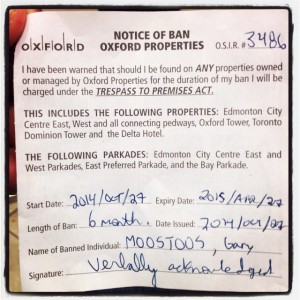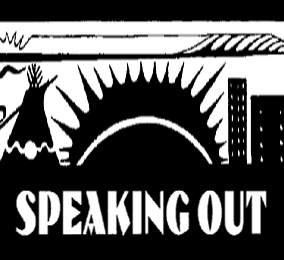Edmonton Elder Gary Moostoos was sitting in the City Centre Mall just finishing his lunch when he was approached by security personnel who demanded his name and his reason for being there. No matter that he was polite and accommodating, explaining his reasons for being at the mall and why he was talking to some so-called criminal types, he was brow-beaten and traumatized initially by two, and then by more than half a dozen security people who tossed him out of the mall and banned him for six months. The story made the front pages for consecutive days and both local and online media must be applauded for the fine job they did in covering the story. Just about anybody who has been in the downtown area during daylight hours knows or has seen Gary Moostoos. Public reaction was immediate, news coverage went international and social media demanded justice.
Mr. Moostoos is a respected and educated Aboriginal Elder, mentor and spiritual adviser who works with the Boyle Street Co-op. Part of his job is to walk the streets in the downtown core where he speaks with and comforts homeless and other less fortunate people, many who have no shelter, food or seasonal clothing. Elder Moostoos refers, offers advice, consoles the traumatized and promotes cultural and traditional healing. He visits the malls, chats with the public and in various ways makes a positive difference in the lives of many people.

Elder Gary Moostoos was banned from an Edmonton mall for looking like someone who caused problems. This is just one example of systemic racism across Canada. Article by John Copley
The day after the incident took place City Centre Mall management offered Gary Moostoos an apology while Mayor Don Iveson offered the mall’s managers/operators help in setting up a cultural sensitivity training session for all staff.
The mall repeated its apology and asked Gary to come in while they investigated his claims. Fortunately for Elder Moostoos he took photos and videoed the entire scenario. The mall did its investigation and in the end admitted that they need to do more to educate their staff. Another apology was forthcoming.
So far Gary Moostoos has refused to accept the apology and rightly so.
He told media that following the incident he went home and cried for hours. In the end he knew he had to bring the matter to light; he already knew that other Aboriginal people had received similar treatment in the mall and was determined to make certain that Edmontonians knew about the situation he was put through.
Staff training is a definite must, not just for City Centre but for malls across the region and throughout the province. In this case, however, because of the severity of the initial action by security staff and the fabrication and on-the-spot-BS by security officers imposing their will no matter what the situation or outcome, the instigators should be let go. Mr. Moostoos was racially profiled by an ill-trained and poorly mannered team of security people, one of whom accuses Mr. Moostoos, on camera, of being “a known violent man.” That’s about as far from the truth as you can get.
Troy Media online columnist Robert McGarvey got it right when he wrote: “It’s too late to apologize; it’s time to do something about racism and cultural prejudice in all its forms.”
He alluded to the irony in this latest incident of bigotry, noting that “after all, Canadians pride themselves on their racial and ethnic diversity. Canada, and Edmonton in particular, has, in past half century, transitioned from a majority (white) Euro-centric ethnicity to a global village with a multiplicity of racial and ethnic constituents. In fact, I would say that one of Edmonton’s great strengths is its ability to move beyond stereotypes and build what can only be described as a truly multi-ethnic society.”
It is true that Edmonton is further advanced than some major Canadian cities when it comes to programs and initiatives that positively affect Aboriginal citizens. We can thank former Mayor Stephen Mandel for helping to make that become a reality and current Mayor Don Iveson for continuing and even expanding the work that Mandel initiated. Despite this, however, racism simply isn’t going away. Yes, there have been significant changes over the past several decades when it comes to society’s acceptance of one another but there’s still a long way to go.
Racism isn’t a Canadian issue but it is a Canadian problem. Hatred and bigotry go back to the beginning of time and Canada is no angel; this country was involved in slavery and Aboriginal people were the primary victims. It wasn’t until 1834 that slavery was outlawed in Canada. Just a few years later, in 1858, Chinese immigrants were brought into the country to work in the mines and on the railroad. They couldn’t vote because they couldn’t obtain Canadian citizenship and as a result were marginalized and subjected to abuse. Today’s Indigenous citizens are the ancestors of this continent’s first peoples; they suffer from a different type of racism than others in Canada’s multi-cultural communities because they know firsthand how racism and innuendo destroy lives.
Stereo-typing and demonizing a person or race because of colour, culture, clothing preferences and personal belief is something that Aboriginal Canadians know all too well. They’ve been subjected to it since birth, a trait that has maintained itself ever since the first so-called civilized governments of this nation realized that they’d have to pay a price for signing treaties that made guarantees no one of that day expected to be fulfilled. Marginalization via non-recognition, isolation, assimilation and forced residential schooling is just the tip of the iceberg when it comes to the collapse of First Nation languages, self-esteem and societal progress and the facts just get colder the deeper you dig.
Racism is systemic and needs to be eradicated at the root. Systemic discrimination is described as comprising “patterns of behaviour, policies or practices that are part of the structures of an organization, and which create or perpetuate disadvantage for racialized persons.”
In this case, it isn’t the structure of an organization but instead the structure of the country that needs to be examined. To eradicate systemic racism you have to begin in the womb; you have to get back to the basics and that all begins in the home, in the classroom, in the workplace and finally in the political and economic arenas.
“This wasn’t an isolated incident,” noted Centre for Race and Culture (CRC) Executive Director Charlene Hay. “It happens frequently. Unfortunately, many people who act and speak in racist terms don’t even realize what they are doing. It’s an inbred trait that needs to be eradicated. Schools, media, doctors, nurses, teachers, major corporations with large number of employees, every possible outlet that can be utilized needs to be doing its part to help quell racism with viable education and cultural sensitivity training.”
Hay said that the CRC supports Gary Moostoos “and celebrates his courage in formally addressing an incident of racism in the City of Edmonton. The case of Gary Moostoos has highlighted the issue of what is pervasive in all organizations and institutions in our society. Racism is most often subtle and even unconscious. We must recognize that we live with the legacy of 500 years of racism. We have the capacity to eliminate it; the first step is to acknowledge that it exists.”
In the aftermath of the intolerable treatment suffered by Gary Moostoos it is obvious that something more needs to be done if racism is ever to be truly snuffed out. It is time for the governments of this nation, the governments of the provinces and the civic and business leaders across this country to create initiatives and take actions that means something. The first step is to rewrite all of the ancient, irrelevant and misleading text being used by elementary, junior and senior high schools across Canada. We must work together as a nation that not only boasts about its multicultural attributes, but creates programs and initiatives that will help ensure that each and every child, and eventually every Canadian, will truly understand and accept one another for who we are as individuals and not judge others by the clothing they wear, the language they speak or the colour of the skin they were born with.
by John Copley




Be the first to comment on "Systemic racism requires more than a bandaid solution"